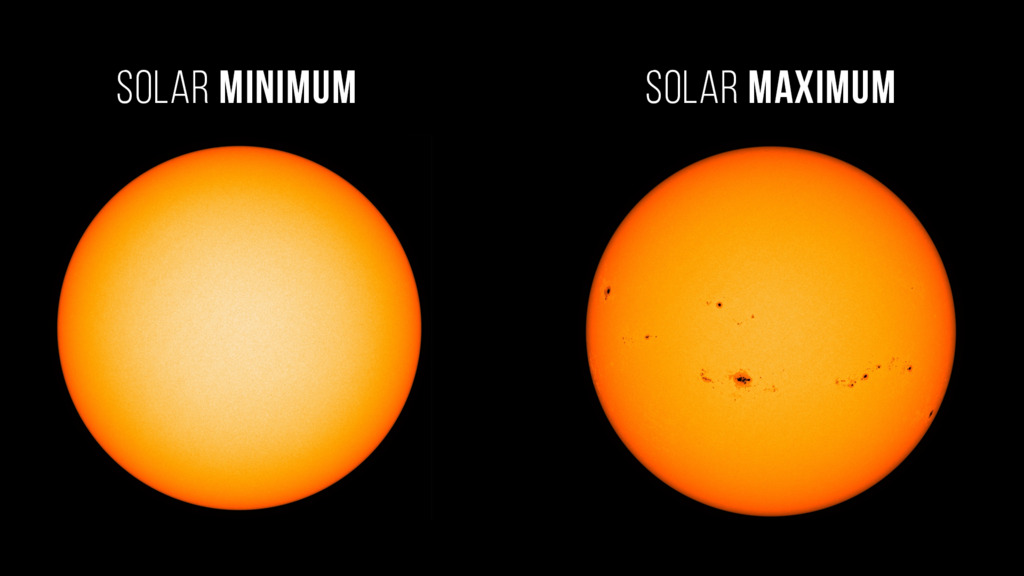Feature image credit: NASA/SDO *
Since solar minimum was declared in December 2019, experts have been closely watching Solar Cycle 25. Unlike the prior cycle—which was the weakest in 100 years—this cycle is showing stronger signs of activity heading into solar maximum, recently confirmed by the National Oceanic and Atmospheric Administration (NOAA) and NASA. What are the implications of heightened solar activity, and how might it impact life on Earth?
The Sun undergoes a periodic cycle of high and low magnetic activity. This takes on average 11 years, with cycles ranging from 9 to 14 years. When the cycle reaches its stormiest, high-intensity state, the magnetic poles of the Sun flip. This is not a short process in fact solar maximums can occur for as long as 2-3 years. During this period, solar geomagnetic activity is at its peak, causing more frequent and widespread displays of the aurorae, which you may have noticed in Edinburgh over the past year or two, as well as offering extra protection from high-energy cosmic rays entering Earth’s atmosphere. This activity is characterised by an increase in sunspots — dark, magnetically active regions on the Sun’s surface. These are often the origin points for solar flares (sudden bursts of radiation from the Sun’s surface) and coronal mass ejections (large eruptions of solar plasma and magnetic fields hurled into space).
In October 2024, NOAA and NASA announced that the Sun had entered its solar maximum, expected to continue into 2025. So far, Solar Cycle 25 has already outpaced expectations, with sunspot numbers exceeding predictions and activity continuing to build into mid-2025. May 2024 alone saw a surge in solar activity, with 82 recorded flares, including nine powerful X-class events, and the strongest geomagnetic storm in over two decades! The Solar Cycle Prediction Panel initially projected a peak sunspot count of around 115, likely occurring between November 2024 and March 2026. More recent forecasts now point to July 2025 as the most probable peak of Solar Cycle 25. Understanding and monitoring this heightened activity is vital, as particularly strong solar activity carries a risk for Earth’s electrical infrastructure.
On the 1st of September 1859, Richard Carrington and Richard Hodgson both individually recorded early observations of a solar flare. By the 2nd, the largest geomagnetic storm of its kind to date had occurred. Across the world, spectacular auroral displays were seen, and in some areas, fires broke out in telegraph stations due to electrical surges, in what would later be labelled as the Carrington event. Although the damage was minimal, if a storm of this scale broke out today, it would have a potentially disastrous impact on the electrical grid. Widespread electrical disruptions and blackouts would arise globally with communication systems being wiped out. Luckily, an event of this scale is rare on Earth, and space weather is regularly monitored.
Declaring solar events like solar maximum or a Carrington-class storm can take months due to the Sun’s activity being unpredictable and not following a smooth pattern. Solar maximum often has more than one peak, with active periods separated by months, making it hard to tell when the true maximum has happened. Scientists collect data from satellites and observatories and average it over time to identify clear trends, as well as compare new events to past ones to judge their strength. This careful approach avoids false alarms and ensures any announcements are based on solid, long-term evidence. This means that we will not know the full picture of the current solar maximum for months or even years after it has concluded.
The Sun follows a dynamic cycle of magnetic activity, and with solar maximum now underway, we’re entering a period of heightened space weather. While this brings stunning auroral displays, it also increases the risk of disruptions to satellites, power grids, and communication systems. As Solar Cycle 25 continues to exceed expectations, careful monitoring will be key. Understanding the Sun’s behaviour not only helps protect our technology, but also prepares us for whatever future solar storms may bring.
Written by Kayleigh Innes, a 3rd year Astrophysics student at the University of Edinburgh.
Edited by Emma Walsh, a 2nd year Biomedical Sciences student at the University of Edinburgh and EUSci Online Editor.
References:
Interrante, A. (2024). NASA, NOAA: Sun Reaches Maximum Phase in 11-Year Solar Cycle – NASA Science. [online] Nasa.gov. Available at: https://science.nasa.gov/science-research/heliophysics/nasa-noaa-sun-reaches-maximum-phase-in-11-year-solar-cycle/.
Kimball, D.S. (1960). A Study of the Aurora of 1859. Geophysical Institute at the University of Alaska.
Bhowmik, P. and Nandy, D. (2018). Prediction of the strength and timing of sunspot cycle 25 reveal decadal-scale space environmental conditions. Nature Communications, 9(1).
Feature image:
* “Visible light images from NASA’s Solar Dynamics Observatory highlight the appearance of the Sun at solar minimum (left, Dec. 2019) versus solar maximum (right, August 2024). During solar minimum, the Sun is often spotless. Sunspots are associated with solar activity, and are used to track solar cycle progress.”


Leave a Reply